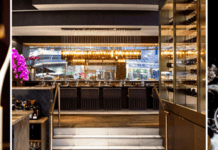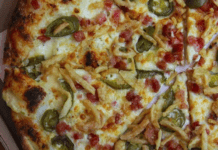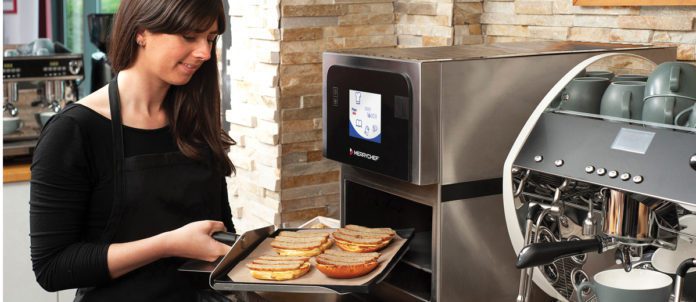The current environment has seen operational shifts accelerate within the foodservice industry. And, along with these changes have come shifts in the equipment that powers these operations. Labour challenges, space constraints and new operation models have all cast a spotlight on accelerated-cooking equipment as the stars of today’s kitchens.
As Greg Hotta, product manager, Welbilt Canada, points out, accelerated cooking is not new. What is new is the demand for this specialized equipment that has grown out of the unique challenges of post-pandemic operations.
Looking at the range of accelerated-cooking solutions, Jeff McMullen, vice-president Sales, Canadian Distribution, Welbilt Canada, notes “All those technologies have been growing pretty rapidly in the last 10 years. But, with COVID-19 and [its associated challenges], a lot of those technologies have really accelerated.” As an example, he points to conveyor ovens, which have seen significant sales growth over the past two years as operators pivot their business models.
Paul Douglas, president, GBS Foodservice Equipment Inc., agrees the kind of operator seeking this equipment has changed due to the current operating environment. Prior to the pandemic, combi-oven sales centred on sophisticated, forward-thinking operations. “Now, all of a sudden, we’ve seen a new wave of operator come to us,” he says of demand for combi-ovens.
“People are much more open to [combi-ovens] today,” Douglas adds. “There was a time when you would talk to chefs…and they would say ‘not interested.’”
A key factor in this changing perspective is the shortage of skilled labour faced by the industry. In this environment, Douglas explains, the question has become “How do we drive volume, consistency, the variety of products we want to put in front of our customer?”
The answer: equipment the delivers on efficiency, versatility, consistency, ease of use and automation. And speed ovens, conveyor ovens, combi-ovens, clam-shell grills and induction cooktops are all checking these boxes.
“Where [operators] have had to rely on manual operations or having a skilled chef to manage the equipment in the past, they can [now] use equipment — such as the Xpress grill, combi-ovens or Merrychef [speed ovens] — to help assist them in that operation, with minimal [staff] intervention, and still get very consistent, high-quality results,” explains Hotta. And, importantly, he adds, programable pieces that are easy to operate also “reduce the waste in the system, which drives profit.”
John Jackson notes the teams at the roster of Calgary restaurants he owns with Connie DeSousa have come to rely on the efficiencies of equipment such as speed, conveyor and combi-ovens through the current industry challenges. “It’s allowed us to be more versatile and grow other brands quickly, even with the labour challenges facing our industry,” he explains, pointing to the new venture Connie & John’s Pizza, which was launched in 2020 and now boasts two locations. And, he adds, it was through the support of Welbilt Canada and a Lincoln conveyor oven that they were able to “build up some working capital and bring back some of our amazing staff.”
Douglas says this has been a common narrative. “Once [operators] started to understand how they could still function [through the pandemic], we saw demand rising from the foodservice sector, [from] people that were changing the way they went to market, changing the way they operated within their kitchen.”
Evolving concepts and operating models have also upped demand for compact and ventless options.
“As these restaurants try to figure out how they’re going to adjust their businesses to the new world, so to speak, ventless technology allows them to put equipment where you couldn’t put equipment before,” explains McMullen. As an example, he points to use of speed ovens in a restaurant’s pick-up area to finish products immediately before they’re picked up.
Jackson also says he values the versatility of the Merrychef units his team uses at Rooftop Bar @ Simmons. “It’s perfect for an area that you don’t have ventilation but are looking for some amazing menu options to execute,” he explains. “Our staff love the simplicity and consistency of the units. We have the ability to cook high-quality menu items very fast with confidence.”
Another new area where these offerings have shone is in ghost-kitchen operations, the growth of which, McMullen points out, was also accelerated by the pandemic.
Douglas points to this as a key area where GBS has seen an increase in combi-oven adoption. “These [operators] have adopted combis because of the volume they can produce and the consistency they can do it with.” Plus, he adds, combi-ovens are especially well suited for operating multiple concepts out of a single kitchen.
“It’s interesting what’s happened and how quickly it’s happened. And, I really don’t believe it’s going to go away,” he adds.
Looking ahead, suppliers expect to see continued growth in the automation and connectivity available within this equipment category.
“Everything is trending more digital and [towards] the ability to operate [equipment] on a more remote basis,” says Douglas. And, he points out, combi-ovens are already “powerful computing units” with increasing cloud capabilities. As the Welbilt team explains, connected kitchens allow for remote management and updates — helping to ensure quality and efficiency.
Welbilt product manager, Luis Dasilva, also points out that connected kitchens offer benefits on the maintenance front. This, he explains, is because having error codes provided by the unit gives valuable insight into what went wrong and how to fix it, “[preventing] any downtime in the restaurant.”
By Danielle Schalk

















